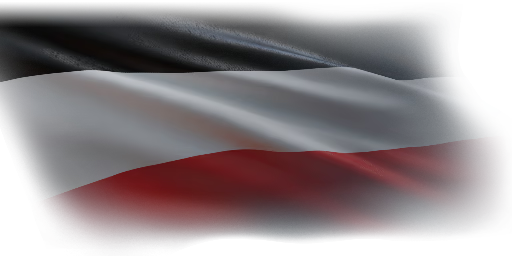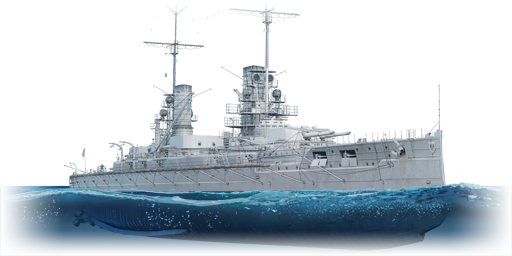




The SMS Kaiser was a German WWI dreadnought, lead ship of the Kaiser class. She had four other sister ships, namely Friedrich der Grosse, Kaiserin, Prinzregent Luitpold and König Albert. Kaiser was ordered as a replacement for obsolete coastal defense ship Hildebrand. She was laid down in September 1909 and launched on 22nd March 1911, this date was chosen on purpose as it was birthday of Kaiser Wilhelm I. His grandson, Kaiser Wilhelm II. attended the ceremony. The primary armament of Kaiser consisted of ten 30.5 cm SK L/50 guns in five twin turrets. Unlike the previous battleships, these weren't in hexagonal arrangement. Instead three were mounted centerline and the other two placed en echelon amidship. Her secondary armament consisted of fourteen 15 cm SK L/45 guns in casemates amidship and twelve 8.8 cm SK L/45 guns out of which four were for anti-aircraft protection. She was also armed with five 50 cm torpedo tubes with one in the bow and four broadside.
In December 1913, Kaiser together with her sister König Albert and light cruiser Strassburg were selected to participate in long distance cruise in order to test reliability of new turbine propulsion system. They departed Germany bound for German colonies in West Africa, then sailed to St. Helena and Rio de Janeiro where they arrived on 15th February 1914. After visiting various other South American ports, the ships left Rio de Janeiro on 16th May, bound for Germany, where they arrived to Kiel on 17th June 1914. The ships sailed about 20,000 nautical miles (37,000 km) during their journey. After the outbreak of WWI, Kaiser conducted several sweeps into the North Sea without seeing much action. On 31st May 1916, Kaiser participated in Battle of Jutland where Kaiser and her sisters were leading the German battle line. During the battle, Kaiser sunk British destroyer HMS Nomad and together with other ships sunk armoured cruiser HMS Defence. Kaiser also engaged and damaged the steering gear of HMS Warspite. Kaiser herself suffered minor damage as she got hit twice by 12 inch guns from HMS Agincourt over the course of battle. In September 1917, Kaiser participated in Operation Albion, German attack on port of Riga where she damaged Russiand destroyer Grom. All five ships of the class survived the war and were scuttled while interned in Scapa Flow in 1919 and subsequently broken up for scrap.
Kaiser was introduced in Update "Ixwa Strike". Unlike the previous Helgoland-class battleship, Kaiser offers improved armour protection as well as better firing angles due to the different turret layout, allowing for firing a full broadside of ten guns unlike Helgoland's eight. When compared to Nassau-class battleships such as Westfalen, Kaiser offers better firepower with its 305 mm calibre guns as opposed to 283 mm found on Westfalen as well as increased armour protection. The ship's machinery and magazines are protected alongside the entire length by coal bunkers. Although after the coal bunkers get destroyed, the ship's magazine become vulnerable to explosion as it's placed relatively close to the waterline and underwater hit by a large calibre shell can pierce the 180 mm thick armour around the magazines with ease.
| Ammunition | Type | Armor penetration (mm) at a distance: | |||||
|---|---|---|---|---|---|---|---|
| 1000 m | 2500 m | 5000 m | 7500 m | 10000 m | 15000 m | ||
| HE | 170 | 154 | 132 | 113 | 97 | 73 | |
| SAP | 487 | 443 | 378 | 324 | 278 | 209 | |
| APC | 525 | 476 | 405 | 346 | 295 | 221 | |
| Ammunition | Type | Armor penetration (mm) at a distance: | |||||
|---|---|---|---|---|---|---|---|
| 1000 m | 2500 m | 5000 m | 7500 m | 10000 m | 15000 m | ||
| HE | 33 | 29 | 23 | 21 | 21 | 21 | |
| SAPBC | 93 | 76 | 53 | 35 | 27 | 25 | |
| APCBC | 235 | 192 | 132 | 89 | 68 | 64 | |
| Ammunition | Type | Armor penetration (mm) at a distance: | |||||
|---|---|---|---|---|---|---|---|
| 100 m | 1000 m | 2000 m | 3000 m | 4000 m | 5000 m | ||
| HE | 12 | 11 | 11 | 11 | 11 | 11 | |











Seakeeping |
|---|
Unsinkability | |
|---|---|
Firepower | ||
|---|---|---|